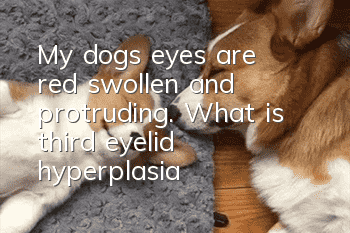My dog’s eyes are red, swollen and protruding. What is third eyelid hyperplasia?

Third eyelid hyperplasia
The dog’s eyes are red, swollen and protruding. It may be that the dog has third eyelid hyperplasia. Third eyelid hyperplasia refers to an eye disease in which the glands located on the spherical surface of the nictitating membrane proliferate and become enlarged, turn outward over the free edge of the nictitating membrane, and protrude from the inner corner of the eye, commonly known as cherry eye. The third eyelid is located within the inner corner of the eye, hidden behind the eye. Under normal circumstances, the naked eye can only see a very small edge at most. The main function of the third eyelid is to physiologically protect the cornea, secrete and distribute tears on the surface of the eyeball, and also clean impurities on the surface of the cornea.
Cause
It may be caused by poor development of the connective tissue between the gland base and the frame periosteum, local stimulation by foreign bodies, or local stress. It may be related to genetics. It may be due to congenital defects or underdevelopment of the connective tissue between the gland base and the orbital tissue, or between the gland and cartilage. Symptoms
Onset occurs in one or both eyes. Pink soft tissue protrudes from the inner eye. Because the glands are exposed to the outside for a long time, they become congested, swollen, and tearful. If they are not restricted, they will rupture in severe cases. Affects tear secretion. Dogs often scratch the affected eyes with their front paws. In the early stage, because the prolapsed gland is small, it can retract on its own within the eyelid. Later, the prolapsed gland becomes enlarged and cannot retract, covering part of the cornea and affecting vision. The color changes from pink to purple in the initial stage, and eye discharge It changes from the initial serous to mucopurulent. If it bleeds due to scratching and ulceration, and secondary bacterial infection occurs, it will cause local inflammation, followed by conjunctivitis and keratitis.Treatment
Generally, general anesthesia and local anesthesia of the affected eye are performed, followed by surgical removal. Surgical resection is the main treatment method. During the resection process, care should be taken to avoid damaging the conjunctiva and nictitating membrane.- What do dogs eat to protect their stomach? It is important to protect their stomach and treat gastrointestinal diseases in dogs.
- How to tell if your dog is fat? Is your dog overweight?
- Will your dog catch a cold if you blow the air conditioner? What should you do if your dog catches a cold if you blow the air conditioner?
- What should you pay attention to when your dog drinks water? Don’t be careless when it comes to your dog’s drinking water.
- The dog's mouth bites and shakes. Why does the dog's mouth occasionally shake and bite?
- How to cut a dog's hair? Do you know how to cut a dog's hair correctly?
- Can dogs eat raw eggs? Why can’t dogs eat egg whites?
- Common Dog Problems in Summer How to Deal with Different Dog Problems
- How to keep dogs away from skin diseases. If you do this, will you see if your dog will still be infected with skin diseases?
- What causes anorexia in dogs? Dogs will become anorexic due to lack of exercise. Hounds run at least 5KM every day.



